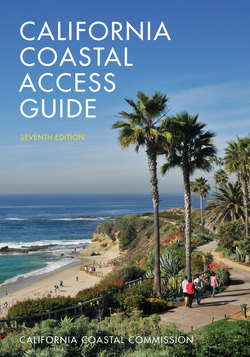Читать книгу California Coastal Access Guide, Seventh Edition - California Coastal Commission - Страница 9
На сайте Литреса книга снята с продажи.
ОглавлениеINTRODUCTION
Pacific Manor Beach, Pacifica, San Mateo County
The California Coastal Access Guide appeared in 1981. The first edition described 721 beaches, paths, and accessways along the state’s 1,271-mile-long coast. Preparation of the guide was carried out by the California Coastal Commission in response to the Legislature’s direction to inventory and map all of the state’s public coastal accessways.
This seventh edition of the California Coastal Access Guide has been revised, reformatted, and updated. Included here are descriptions of more than 1,150 points at which the public can gain access to the coast of California. Along with beaches and access paths are interpretive centers, boating facilities, nature preserves, maritime museums, and other coast-related facilities that serve visitors.
Continuing their work to increase opportunities for legal, safe access to the shoreline are the California Coastal Commission, State Coastal Conservancy, San Francisco Bay Conservation and Development Commission, State Parks Department, local governments, and nonprofit land trusts. Each has a role to play in expanding opportunities for residents and visitors to enjoy and learn about California’s magnificent coast. This book is offered with the knowledge that a wide appreciation for the coast among Californians plays an important role in the protection of coastal resources.
More than a quarter of the California coastline, some 295 miles of shore, is encompassed within the state park system. Parks managed by federal, county, and city entities include many more miles of coast. The state of California owns all tidelands, submerged lands, and the beds of inland navigable waters, holding them for “public trust” uses that include fishing, navigation, commerce, nature preserves, swimming, boating, and walking. Tidelands consist of the area on a beach or rocky coastline that is between the mean high tide line and the mean low tide line. The California Constitution guarantees the public’s right of access to tidelands. The state of California (or other managing agency), however, may place restrictions on the time, place, and manner of use of tidelands.
Private property exists along the California coast in many locations, inland of the tidelands. The public generally does not have a right to cross private property without permission to get to tidelands, although easements and deed restrictions allow public use of some private shoreline properties. When using tidelands, members of the public should exercise caution when there is a potential for encroaching on private land. Land owners similarly should be cautious in questioning the public’s right to be on areas of the beach covered by public rights.
Keep in Mind
Additional information on public rights on certain beaches is available on the Access Program pages of the California Coastal Commission’s website at www.coastal.ca.gov.
This guide describes selected activities that might enhance a visit to the coast, with emphasis on active pursuits, learning opportunities, and perhaps unexpected activities. Introductory pages in each county chapter describe additional activities that are well suited to that locale. Separating the chapters are feature that provide additional suggestions of things to do. Coastal access sites mentioned in the county introductions and in feature articles are marked in boldface type; consult the index to find more information on each site. Use the index also to search for lighthouses, boat launches, fishing piers, and sites for other activities.
Campgrounds and hostels that provide lower-cost overnight accommodations are listed here; plenty of other guides are available that list other lodging opportunities. For more information about the resources of the state’s magnificent coast, including its wildlife and flora, geology, and historic communities, see the Coastal Commission’s companion series of four guidebooks, entitled Experience the California Coast.
Enjoy your visits to California’s spectacular coast. Keep safe along hazardous stretches of shoreline by observing posted restrictions. Remember that sleeper waves are always possible; do not turn your back on the ocean. When possible, swim near a lifeguard. Lifeguards patrol many parts of the coast year-round, although lifeguard towers on the sand (mostly in central and southern California) are generally staffed daily only during the summer. Natural conditions along the California coast are always changing, and the width of beaches and shape of bluffs can be altered by the seasonal movement of sand or by erosion. Further, coastal access facilities may be out of service or closed due to budget constraints. When planning any trip to the coast, check ahead of time to make sure that your destination is currently accessible.
Keep in Mind
Dogs on a leash no longer than six feet are allowed in some developed areas within state parks, including many picnic areas, paved roads, and campgrounds (if kept in a vehicle or tent), unless posted otherwise. Other than service animals, dogs are generally not allowed on state park trails or beaches; exceptions are noted in this guide.
Using This Guide
Coastal access points are listed from north to south. Each group of sites is accompanied by a map and a chart of key characteristics and amenities. The “Facilities for Disabled” chart category includes wheelchair-accessible restrooms, trails, campsites, or visitor centers; text descriptions note where restrooms are not wheelchair accessible. Use of some facilities may require assistance. The “Easy for Strollers” category indicates sites that are readily negotiated by visitors pushing strollers, those who walk with a cane, or others with limited mobility. The “Fee” category refers to a charge for entry, parking, or camping. “Dog friendly” sites are noted. Unless otherwise indicated, dogs must be leashed. Watch for posted restrictions, which may change. Most parks and recreational facilities maintain websites, but URL addresses change often; use any popular Internet search engine to look for more information about facilities in this guide.
Charts include the categories listed here.
Sandy Beach
Rocky Shore
Trail
Bicycle Trail
Campground
Beach Shower
Boating Facilities
Wildlife Viewing
Fishing
Dog Friendly
Children’s Playground
Visitor Center
Historic Structure
Facilities for Disabled
Easy for Strollers
Food or Drink
Restrooms
Parking
Fee
